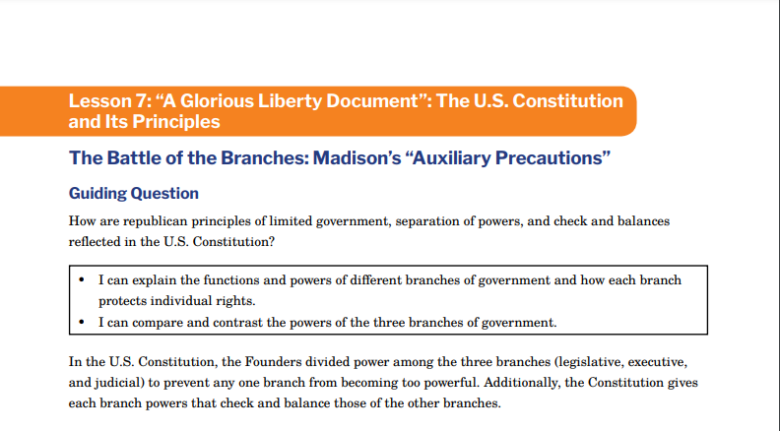The Battle of the Branches: Madison’s “Auxiliary Precautions”
The Battle of the Branches: Madison’s “Auxiliary Precautions”
Guiding Question: How are republican principles of limited government, separation of powers, and checks and balances reflected in the U.S. Constitution?
- I can explain the functions and powers of different branches of government and how each branch protects individual rights.
- I can compare and contrast the powers of the three branches of government.
In the U.S. Constitution, the Founders divided power among the three branches (legislative, executive, and judicial) to prevent any one branch from becoming too powerful. Additionally, the Constitution gives each branch powers that check and balance those of the other branches.
Essential Vocabulary
| impeach | officially charge with misconduct |
| judicial review | a process through which the judicial branch can declare laws and presidential actions unconstitutional |
My assigned branch:
Your task is to create a product (poster, commercial, comic, song—be creative!) that explains the following:
- The main function of your branch of government
- How this branch checks the powers of the other two branches of government
- Why this branch of government is key to the protection of rights
After all groups present their products, the class will determine if there is a true winner in the Battle of the Branches.
| Separation of Powers |
|---|
| The legislature makes the law. |
| The executive enforces the law. |
| The judiciary interprets the law. |
| Checks and Balances |
| The president (head of the executive branch) serves as commander in chief of the military, but Congress (legislative branch) appropriates funds for the military and votes to declare war. In addition, the Senate must ratify any peace treaties. |
| Congress controls the money used to fund any executive actions. |
| The president nominates federal officials, and the Senate confirms those nominations. |
| Within the legislative branch, each house of Congress serves as a check on possible abuses of power by the other. Both the House of Representatives and the Senate have to pass a bill in the same form for it to become law. |
| Once Congress has passed a bill, the president has the power to veto that bill. Congress can override a regular presidential veto by a two-thirds vote in both houses. |
| The Supreme Court and other federal courts (judicial branch) can declare laws or presidential actions unconstitutional in a process known as judicial review. |
| In turn, the president checks the judiciary through the power of appointment, which can be used to change the direction of the federal courts. |
| Congress (considered the branch of government closest to the people) can impeach [charge with misconduct] members of both the executive and judicial branches. |
Concluding Analysis and Reflection
- Based on the products created by your class, was there a clear winner in the Battle of the Branches? Why or why not?
- Madison claimed in Federalist No. 39 that “supremacy is completely vested in the national legislature.” Why do you think he believed this to be true? Do you think this is true in the present day? Why or why not? Use specific examples to support your opinion.






